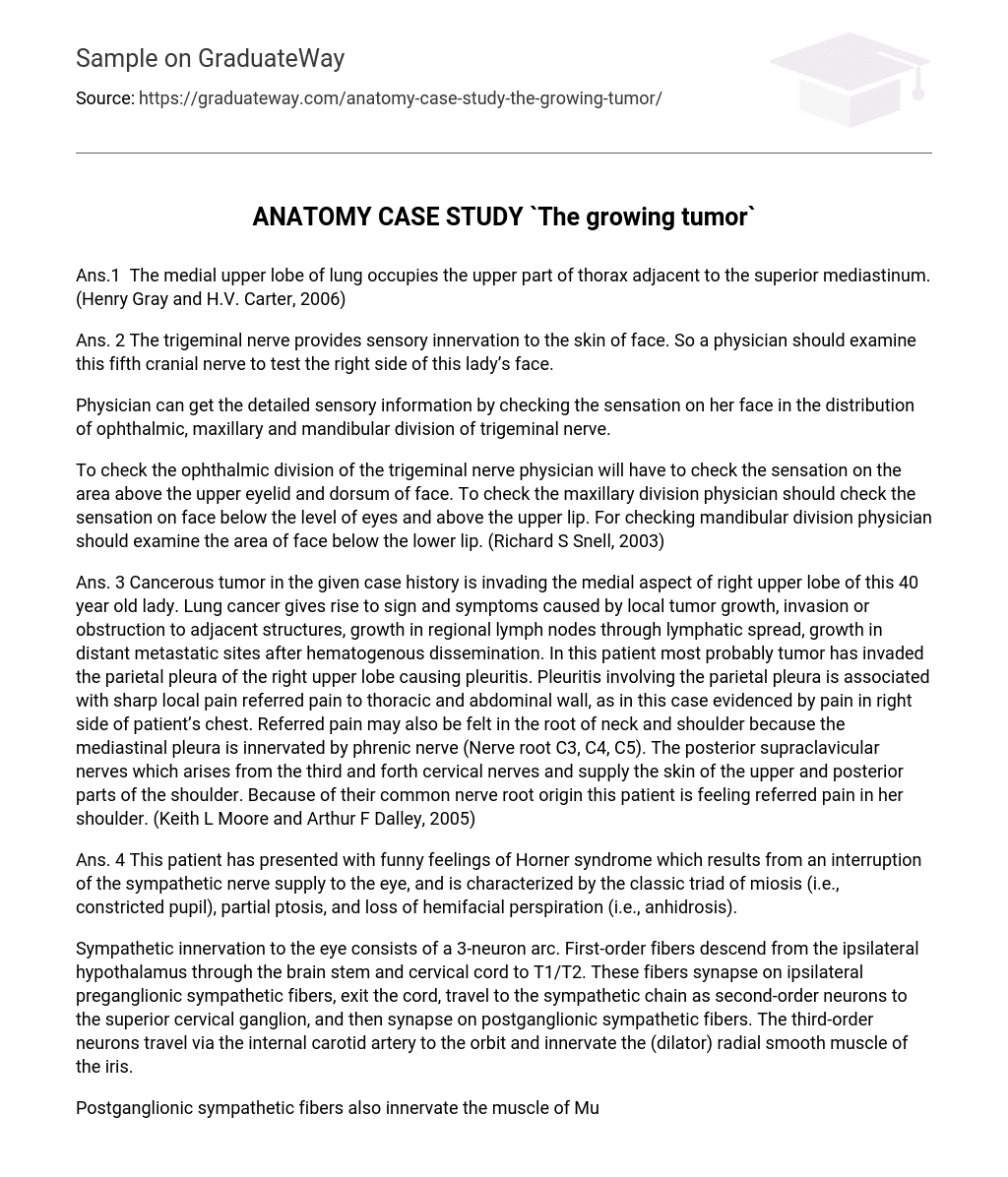Ans.1 The medial upper lobe of lung occupies the upper part of thorax adjacent to the superior mediastinum. (Henry Gray and H.V. Carter, 2006)
Ans. 2 The trigeminal nerve provides sensory innervation to the skin of face. So a physician should examine this fifth cranial nerve to test the right side of this lady’s face.
Physician can get the detailed sensory information by checking the sensation on her face in the distribution of ophthalmic, maxillary and mandibular division of trigeminal nerve.
To check the ophthalmic division of the trigeminal nerve physician will have to check the sensation on the area above the upper eyelid and dorsum of face. To check the maxillary division physician should check the sensation on face below the level of eyes and above the upper lip. For checking mandibular division physician should examine the area of face below the lower lip. (Richard S Snell, 2003)
Ans. 3 Cancerous tumor in the given case history is invading the medial aspect of right upper lobe of this 40 year old lady. Lung cancer gives rise to sign and symptoms caused by local tumor growth, invasion or obstruction to adjacent structures, growth in regional lymph nodes through lymphatic spread, growth in distant metastatic sites after hematogenous dissemination. In this patient most probably tumor has invaded the parietal pleura of the right upper lobe causing pleuritis. Pleuritis involving the parietal pleura is associated with sharp local pain referred pain to thoracic and abdominal wall, as in this case evidenced by pain in right side of patient’s chest. Referred pain may also be felt in the root of neck and shoulder because the mediastinal pleura is innervated by phrenic nerve (Nerve root C3, C4, C5). The posterior supraclavicular nerves which arises from the third and forth cervical nerves and supply the skin of the upper and posterior parts of the shoulder. Because of their common nerve root origin this patient is feeling referred pain in her shoulder. (Keith L Moore and Arthur F Dalley, 2005)
Ans. 4 This patient has presented with funny feelings of Horner syndrome which results from an interruption of the sympathetic nerve supply to the eye, and is characterized by the classic triad of miosis (i.e., constricted pupil), partial ptosis, and loss of hemifacial perspiration (i.e., anhidrosis).
Sympathetic innervation to the eye consists of a 3-neuron arc. First-order fibers descend from the ipsilateral hypothalamus through the brain stem and cervical cord to T1/T2. These fibers synapse on ipsilateral preganglionic sympathetic fibers, exit the cord, travel to the sympathetic chain as second-order neurons to the superior cervical ganglion, and then synapse on postganglionic sympathetic fibers. The third-order neurons travel via the internal carotid artery to the orbit and innervate the (dilator) radial smooth muscle of the iris.
Postganglionic sympathetic fibers also innervate the muscle of Mueller within the eyelid. This muscle is responsible for initiating eyelid retraction during eyelid opening. Postganglionic sympathetic fibers responsible for facial sweating follow the external carotid artery to the sweat glands of the face. Interruption at any location along this pathway results in ipsilateral Horner syndrome.
Horner syndrome may result from a lesion of the primary neuron; brainstem stroke or tumor or syrinx of the preganglionic neuron; trauma to the brachial plexus; tumors (e.g., Pancoast) or infection of the lung apex; a lesion of the postganglionic neuron; dissecting carotid aneurysm; carotid artery ischemia; migraine; or middle cranial fossa neoplasm.
The common lesions that cause Horner syndrome interfere with preganglionic fibers as they course through the upper thorax. Preganglionic Horner syndrome indicates a serious underlying pathology and is associated with a high incidence of malignancy. Common causes of acquired preganglionic Horner syndrome include trauma, aortic and carotid dissection and Pancoast tumor, metastasis to cervical lymph nodes, and sarcoidosis or tuberculosis of cervical lymph nodes. (Brian R. Shmaefsky, 2007)
Ans. 5 If the lesion grew upward and more towards midline it will start invading the structures around. It may cause tracheal obstruction, esophageal compression with dysphagia, recurrent laryngeal nerve paralysis with hoarseness, phrenic nerve paralysis with elevation of hemi-diaphragm and dyspnea, Pancoast syndrome results from local extension of tumor growing in apex of lung with involvement of eighth cervical an first and second thoracic=c nerves, with shoulder pain that characteristically radiate in the ulnar distribution of arm, often with radiologic destruction of first and second ribs.
All intrinsic muscles of the larynx are innervated by inferior laryngeal nerve of cranial nerve X (a continuation of the recurrent laryngeal nerve), except the cricothyroid muscle, which is innervated by external branch of superior laryngeal nerve of Cranial nerve X. So in a patient presenting with hoarseness his tenth cranial, the Vagus nerve must be checked. (Keith L Moore and Anne MR Agur, 2006)
References:
Keith L Moore and Anne MR Agur (2006). Essential Clinical Anatomy (Point (Lippincott Williams & Wilkins))
Richard S Snell (2003). Clinical Anatomy
Keith L Moore and Arthur F Dalley (2005). Clinically Oriented Anatomy (5th Edition)
Henry Gray and H.V. Carter (2006) Gray’s Anatomy: A Facsimile – Illustrated
Brian R. Shmaefsky (2007). Applied Anatomy & Physiology: A Case Study Approach- Student Edition





